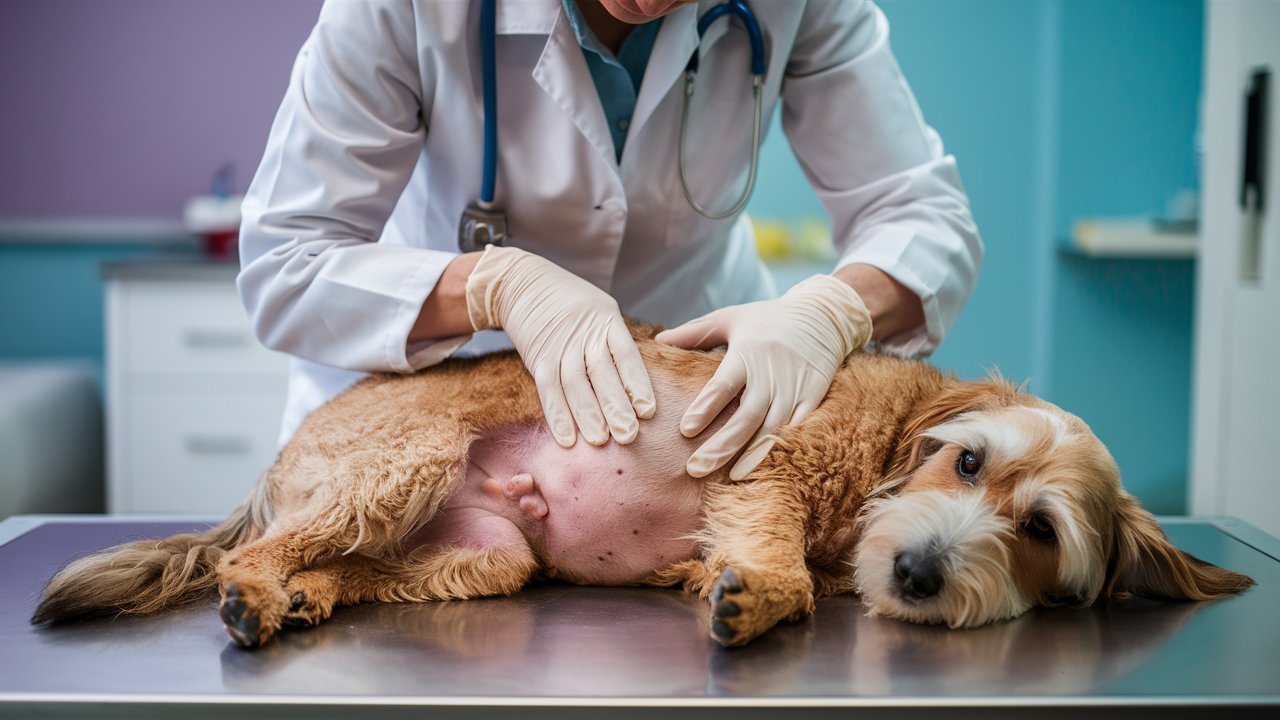Phantom Pregnancies in Dogs: 100% Comprehensive Management Guide
Phantom Pregnancies in Dogs, also known as false pregnancy or pseudocyesis, is a fascinating yet perplexing condition that affects many female dogs. This phenomenon can cause a range of physical and behavioral changes that mimic the symptoms of actual pregnancy, despite the absence of fertilization. Understanding phantom pregnancy in dogs is crucial for pet owners, breeders, and veterinarians to provide appropriate care and manage the condition effectively.
In this article, we will explore the causes, symptoms, diagnosis, and treatment options for phantom pregnancy in dogs. Additionally, we’ll delve into the psychological impact on the affected dogs and share personal anecdotes to make the topic relatable and engaging.
Table of Contents
TogglePhantom Pregnancies in Dogs?

Phantom Pregnancies in Dogs occurs when a female dog exhibits signs of pregnancy despite not being pregnant. This condition is primarily driven by hormonal changes in the dog’s body, particularly after her heat cycle. The hormonal fluctuations can cause the dog’s body to behave as if it is pregnant, leading to a variety of physical and behavioral symptoms.
Causes of Phantom Pregnancies in Dogs
The exact cause of Phantom Pregnancies in Dogs is not fully understood, but it is believed to be linked to hormonal imbalances. During a dog’s heat cycle, her ovaries produce progesterone, a hormone that prepares the body for Phantom Pregnancies in Dogs. If the dog does not become pregnant, the levels of progesterone eventually drop, leading to the production of another hormone called prolactin. Prolactin is responsible for milk production and maternal behaviors, and elevated levels can trigger the symptoms of a false Phantom Pregnancies in Dogs.
Symptoms of Phantom Pregnancies in Dogs
The symptoms of Phantom Pregnancies in Dogs can vary widely, and not all dogs will exhibit the same signs. Common symptoms include:
Physical Symptoms Phantom Pregnancies in Dogs
- Enlarged Abdomen: The dog’s abdomen may appear swollen, mimicking the appearance of a pregnant belly.
- Mammary Gland Enlargement: The dog’s mammary glands may become swollen and may even produce milk.
- Nesting Behavior: The dog may start to gather toys, blankets, or other objects and create a nest-like area.
- Decreased Appetite: Some dogs may lose interest in food or eat less than usual.
- Weight Gain: Despite a decreased appetite, some dogs may gain weight due to hormonal changes.
- Lethargy: The dog may become less active and appear lethargic.
Behavioral Symptoms Phantom Pregnancies in Dogs
- Maternal Behavior: The dog may exhibit strong maternal instincts, such as licking and caring for toys or other objects as if they were puppies.
- Restlessness: The dog may become restless and have difficulty settling down.
- Anxiety: Increased anxiety and clinginess towards the owner can occur.
- Aggression: In some cases, the dog may become more protective and exhibit aggressive behavior.
Personal Anecdote: Bella’s Phantom Pregnancies in Dogs
To illustrate the impact of Phantom Pregnancies in Dog’s behavior, let me share the story of Bella, a five-year-old Labrador Retriever. Bella had always been a playful and affectionate dog, but one summer, she started exhibiting unusual behaviors. She became extremely attached to a stuffed toy, carrying it everywhere and treating it as if it were a real puppy. Bella also began nesting in her bed, rearranging blankets and pillows to create a cozy spot.
Bella’s owner, Sarah, initially thought Bella might be pregnant, but a visit to the vet confirmed that it was a phantom pregnancy. The vet explained the hormonal changes Bella was experiencing and provided guidance on how to manage the condition. With patience and understanding, Sarah was able to help Bella through her phantom pregnancy, ensuring she remained comfortable and stress-free.
Diagnosing Phantom Pregnancies in Dogs

If you suspect your dog is experiencing Phantom Pregnancies in Dogs, it is essential to consult a veterinarian for a proper diagnosis. The vet will conduct a thorough physical examination and may perform diagnostic tests to rule out other potential causes of the symptoms, such as actual pregnancy or underlying medical conditions.
Diagnostic Tests
- Ultrasound: An ultrasound can help determine if the dog is actually pregnant by visualizing the presence or absence of fetuses.
- Blood Tests: Blood tests can measure hormone levels, including progesterone and prolactin, to identify hormonal imbalances.
- Physical Examination: The vet will examine the dog’s abdomen, mammary glands, and overall health to assess the symptoms.
Managing Phantom Pregnancies in Dogs
Managing a Phantom Pregnancies in Dogs involves addressing both the physical and behavioral symptoms. Here are some strategies to help your dog through this condition:
Physical Care
- Comfortable Environment: Provide a comfortable and quiet space for your dog to rest. Avoid unnecessary stressors and loud noises.
- Monitoring Mammary Glands: If the dog’s mammary glands are producing milk, monitor for signs of mastitis (inflammation of the mammary glands) and seek veterinary care if necessary.
- Diet and Exercise: Maintain a balanced diet and regular exercise routine to prevent weight gain and keep your dog healthy.
Behavioral Support
- Distracting Activities: Engage your dog in activities that distract her from nesting and maternal behaviors. Play with her favorite toys, go for walks, and provide mental stimulation.
- Limit Access to Nesting Materials: Remove objects that your dog may use for nesting, such as blankets and stuffed toys, to reduce maternal behaviors.
- Positive Reinforcement: Use positive reinforcement techniques to encourage normal behavior and reward your dog for engaging in activities other than nesting.
Treatment Options
In some cases, veterinary intervention may be necessary to manage a phantom pregnancy. Treatment options may include:
Medications
- Hormonal Therapy: Medications that regulate hormone levels, such as cabergoline, can help reduce the symptoms of phantom pregnancy.
- Anti-Anxiety Medications: If the dog is experiencing significant anxiety, the vet may prescribe anti-anxiety medications to help manage the condition.
Spaying
Spaying (ovariohysterectomy) is a surgical procedure that removes the ovaries and uterus, preventing future heat cycles and phantom pregnancies. Spaying is often recommended for dogs that experience recurrent phantom pregnancies or severe symptoms.
Long-Term Management and Prevention

Preventing and managing phantom pregnancies in dogs requires a comprehensive approach that encompasses regular veterinary care, lifestyle adjustments, and sometimes surgical intervention. Here’s a detailed look at how to effectively manage and prevent phantom pregnancies over the long term.
Regular Veterinary Check-Ups
Regular veterinary check-ups are crucial in monitoring your dog’s overall health and hormonal balance. These check-ups can help in the early detection of any hormonal imbalances that might predispose Phantom Pregnancies in Dogs.
- Frequency: Schedule at least biannual check-ups, or more frequently if your dog has a history of phantom pregnancies.
- Hormone Monitoring: Discuss with your vet the possibility of periodic hormone level testing, especially after your dog’s heat cycles.
- Physical Examinations: Regular physical exams can help detect early signs of mammary gland changes or other physical symptoms indicative of Phantom Pregnancies in Dogs.
Spaying
Spaying is the most effective way to prevent Phantom Pregnancies in Dogs. This surgical procedure involves the removal of the ovaries and uterus, eliminating the hormonal fluctuations that lead to Phantom Pregnancies in Dogs.
- Timing: Consult your vet about the best timing for spaying. It is often recommended to spay dogs who are not intended for breeding after they reach sexual maturity but before they experience multiple heat cycles.
- Health Benefits: In addition to preventing phantom pregnancies, spaying reduces the risk of uterine infections (pyometra) and certain types of cancers (e.g., mammary gland tumors).
- Recovery: Ensure you follow post-operative care guidelines to ensure a smooth recovery. This includes monitoring the incision site, limiting physical activity, and providing a comfortable recovery environment.
Stress Reduction Phantom Pregnancies in Dogs
Stress can exacerbate hormonal imbalances and contribute to the occurrence of Phantom Pregnancies in Dogs. Minimizing stressors in your dog’s environment is a key preventive measure.
- Routine: Establish a consistent daily routine to provide your dog with a sense of stability and security.
- Safe Space: Create a safe and quiet space where your dog can retreat to when feeling anxious or overwhelmed.
- Positive Reinforcement: Use positive reinforcement techniques to build your dog’s confidence and reduce anxiety-related behaviors.
Diet and Exercise
A balanced diet and regular exercise are fundamental to maintaining your dog’s overall health and hormonal balance.
- Nutrition: Provide a high-quality, balanced diet that meets your dog’s nutritional needs. Consult your vet for recommendations based on your dog’s age, breed, and health status.
- Weight Management: Maintain a healthy weight to prevent obesity, which can affect hormone levels and overall health.
- Exercise: Ensure your dog gets regular physical activity to keep her fit and mentally stimulated. Tailor the exercise routine to your dog’s age and energy levels.
Behavioral Management
Addressing and managing behaviors associated with phantom pregnancies can help reduce their impact on your dog’s well-being.
- Distracting Activities: Engage your dog in activities that divert her attention from nesting and maternal behaviors. This can include interactive toys, puzzle feeders, and training exercises.
- Limit Access to Nesting Materials: Remove objects that your dog may use for nesting, such as blankets and stuffed toys, especially during and after her heat cycle.
- Socialization: Ensure your dog gets plenty of social interaction with other dogs and humans to keep her mentally stimulated and reduce anxiety.
Monitoring and Early Intervention
Being vigilant and recognizing the early signs of a phantom pregnancy can help in managing the condition more effectively.
- Symptom Awareness: Familiarize yourself with the symptoms of phantom pregnancies in dogs, such as mammary gland enlargement, nesting behavior, and changes in appetite or behavior.
- Prompt Veterinary Care: If you notice any signs of a phantom pregnancies in dogs, consult your vet promptly for advice and potential treatment options.
Personal Anecdote: Charlie’s Journey to a Balanced Life
Charlie, a four-year-old Border Collie, had a history of phantom pregnancies that left her owner, Lisa, feeling concerned and helpless. Charlie’s first phantom pregnancy occurred after her second heat cycle. She exhibited strong nesting behaviors, gathered toys, and became unusually protective and anxious. Lisa initially thought Charlie might be pregnant, but a visit to the vet confirmed it was a phantom pregnancy.
After several episodes, Lisa and her vet decided to take a multi-faceted approach to manage Charlie’s condition. They implemented regular veterinary check-ups, focusing on hormone monitoring. Lisa also worked on reducing stress in Charlie’s environment by creating a consistent routine and a safe space for her to retreat to when anxious. A balanced diet and regular exercise were also prioritized to maintain Charlie’s overall health.
Despite these efforts, Charlie continued to experience phantom pregnancies, prompting Lisa to consider spaying. After thorough discussions with her vet, Lisa decided to proceed with the surgery. The procedure went smoothly, and Charlie’s recovery was swift. Post-surgery, Charlie’s episodes of phantom pregnancy ceased, and she returned to her playful, energetic self.
Lisa’s experience with Charlie taught her the importance of comprehensive care and proactive measures in managing her dog’s health. She now shares her story to help other dog owners understand the value of regular veterinary care, stress management, and the potential benefits of spaying.
Personal Anecdote: Daisy’s Journey to Wellness

Daisy, a three-year-old Beagle with soulful eyes and a wagging tail that never seemed to stop, was the light of Emily’s life. From the moment Emily adopted Daisy from a local shelter, the two had been inseparable. They enjoyed long walks in the park, lazy afternoons on the couch, and countless adventures that created a deep bond between them.
The First Signs
It was during one of those serene summer evenings that Emily first noticed something unusual about Daisy. Daisy began to exhibit nesting behaviors, gathering her toys and blankets into a cozy pile. At first, Emily found it endearing, thinking Daisy was just making herself comfortable. However, as days passed, Daisy’s behavior became more intense. She started to carry her favorite stuffed toy everywhere, treating it with a gentleness and protectiveness that Emily had never seen before.
Daisy also became increasingly restless, pacing around the house and whining softly. Her normally voracious appetite diminished, and she seemed more anxious and clingy than usual. Concerned, Emily decided it was time to visit their veterinarian.
The Vet Visit
At the veterinary clinic, Dr. Mitchell conducted a thorough examination of Daisy. He listened as Emily described the changes in Daisy’s behavior and noted the swelling in her mammary glands. Dr. Mitchell explained that Daisy was experiencing a phantom pregnancy, a condition where hormonal changes mimic the signs of actual pregnancy.
Emily was both relieved and worried. Relieved that Daisy wasn’t sick, but worried about how to help her beloved dog through this confusing time. Dr. Mitchell provided guidance on managing Daisy’s symptoms and discussed the possibility of spaying to prevent future occurrences.
Coping with Phantom Pregnancy
Over the next few weeks, Emily focused on making Daisy as comfortable as possible. She removed the nesting materials and the stuffed toy that Daisy had become so attached to, replacing them with interactive toys to keep Daisy’s mind occupied. Emily spent extra time playing with Daisy and taking her on longer walks to help alleviate her restlessness and anxiety.
Despite these efforts, Daisy’s maternal behaviors persisted, and she seemed increasingly distressed. Emily’s heart ached to see her usually joyful companion in such a state of confusion and discomfort. After several discussions with Dr. Mitchell, Emily decided it was time to consider spaying Daisy to prevent future phantom pregnancies and provide her with long-term relief.
The Decision to Spay
Emily was initially apprehensive about the surgery. The thought of Daisy undergoing a major procedure was daunting. However, Dr. Mitchell reassured her that spaying was a routine surgery with significant benefits, especially for dogs like Daisy who experienced recurrent phantom pregnancies. Emily wanted the best for Daisy and knew that this decision was ultimately for her well-being.
On the day of the surgery, Emily felt a mix of anxiety and hope. She dropped Daisy off at the clinic, giving her a reassuring hug and a promise that everything would be okay. The hours that followed were some of the longest Emily had ever experienced. She waited anxiously by the phone, hoping for good news.
The Road to Recovery
When Dr. Mitchell called to inform Emily that the surgery had gone smoothly, she felt an overwhelming sense of relief. Daisy was groggy but recovering well. Emily brought her home and set up a cozy recovery area with soft bedding and her favorite toys.
The days following the surgery were challenging as Daisy adjusted and healed. Emily was by her side every step of the way, administering medications, monitoring her incision, and providing endless love and comfort. Slowly but surely, Daisy began to regain her energy and playful spirit.
A Happy Ending
As weeks turned into months, Emily noticed a remarkable change in Daisy. The anxiety and restlessness that had plagued her during phantom pregnancies were gone. Daisy was back to her old self—playful, affectionate, and full of life. The bond between Emily and Daisy grew even stronger through this shared experience.
Emily often reflects on Daisy’s journey to wellness with gratitude. The decision to spay Daisy was not an easy one, but it was the right choice for her health and happiness. Daisy’s story serves as a reminder of the importance of understanding and addressing the unique health needs of our furry companions.
A Message to Other Dog Owners
Emily now encourages other dog owners to be vigilant and proactive when it comes to their pets’ health. Phantom pregnancies can be distressing for both the dog and the owner, but with proper care and veterinary support, they can be managed effectively. Spaying, in particular, can offer a long-term solution and prevent future occurrences.
If you suspect your dog is experiencing a phantom pregnancy, don’t hesitate to seek veterinary advice. Each dog is unique, and what works for one may not work for another. By staying informed and compassionate, you can help your dog navigate through challenging times and ensure her well-being.
Conclusion
Phantom pregnancy in dogs is a complex and often misunderstood condition that can have a significant impact on both the dog and her owner. Understanding the causes, symptoms, and treatment options is essential for providing appropriate care and support. By staying informed and proactive, pet owners can help their dogs navigate through phantom pregnancies with minimal discomfort and stress.
If your dog experiences symptoms of a phantom pregnancy, consult your veterinarian for guidance and support. Remember, each dog is unique, and the approach to managing a phantom pregnancy may vary. With patience, understanding, and proper care, you can help your furry friend through this challenging experience and ensure her well-being.





